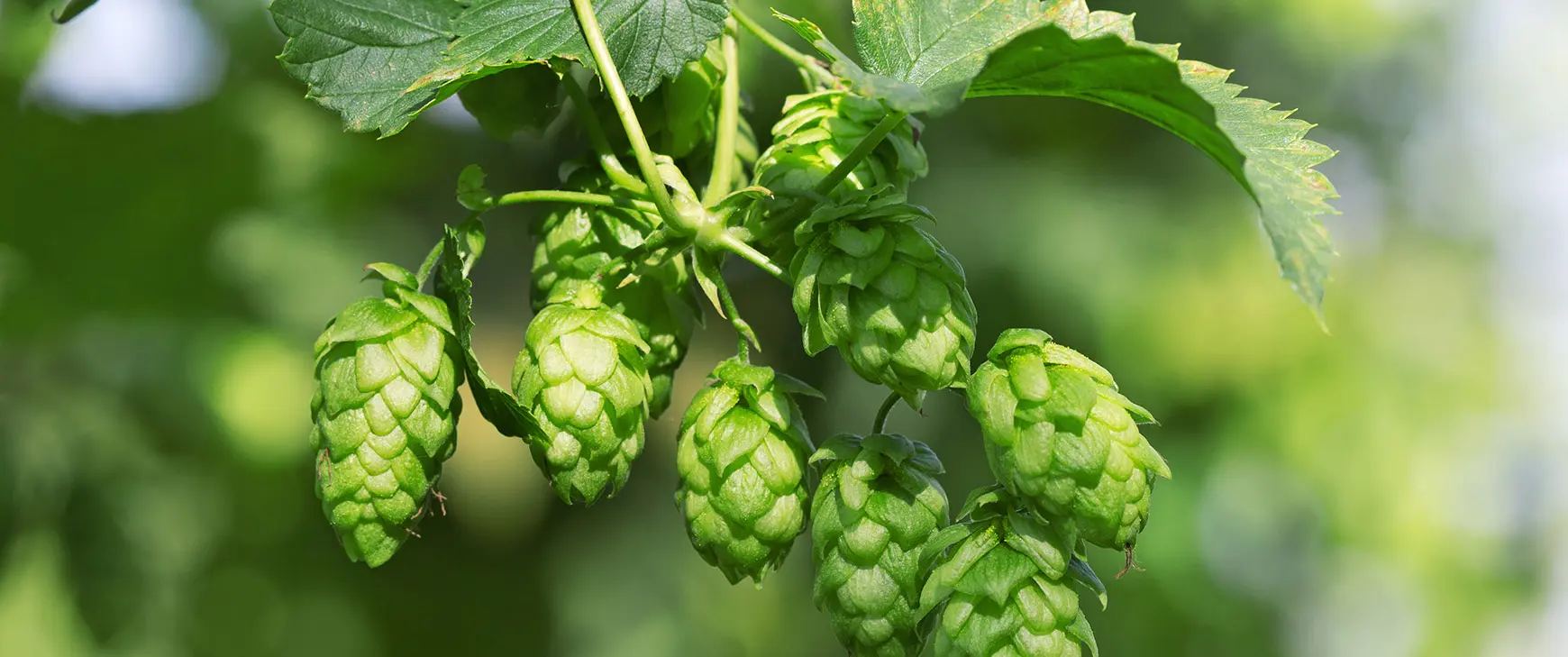
Phyto Story - Hops (Humulus lupulus)
Many people are aware that hops (Humulus lupulus) are used to make beer. While beer does have a sleep-inducing effect, this is mainly due to the alcohol it contains. Alcohol might sometimes help a person fall asleep, but it prevents restful sleep through the night because it disrupts the natural sleep pattern. However, when taken in an appropriate preparation, hops work as a sleep aid to consistently promote natural sleep. Hops are especially effective when combined with valerian root. Read on to learn more about hops, the cultural history of the plant and how it is used as a remedy for sleep disorders.
October 29, 2020
Origins and habitats of the hop plant
There are three species of hops in the Humulus genus, which belongs to the hemp family (Cannabaceae). The other two species are rare and found only in certain parts of Asia, whereas the common hop (Humulus lupulus) is found all over central Europe. Wild hop often grows in nitrogen-rich places in lowland forests, at the edges of forests and near bodies of water.
The hop plant can be found in the wild, but it is mainly cultivated. Such cultivated varieties are grown on a mass scale. Around 95 per cent of the harvest is used for beer production. The rest of the “cones” are used for medicinal products that promote sleep. Hops are mainly grown the United States, Germany and the Czech Republic.
What do hops look like?
The hop plant is a perennial twining vine, or bine. It has three-lobed leaves with saw-toothed edges. Because the plant winds clockwise around objects to help it climb, it is referred to as a right-handed bine. Cultivated varieties can grow to a height of ten metres. The plant is typically grown on high frames in hop gardens.
The hop is a dioecious plant, meaning that it is purely female or purely male. Only the female plants are cultivated. These produce the hop cones used in medicinal products and beer-making. The clusters are harvested from the end of August onwards and then gently dried.
Cultural history of the hop plant
The first purity laws for beer go back to the Middle Ages, when beer was only allowed to contain hops, malt and water. The hop cones were used for their aroma and bitterness as well as for their preservative properties. In 1153, Hildegard von Bingen said that the bitterness of hops prevented spoiling (“putredines prohibet in amaritudine sua”). Hop cones also have a long tradition of use in botanical sleep aids.
Wild hop was also used for many other purposes, however. Libraries used small sacks filled with hop to absorb moisture. The essential oils in hops also protected books against pests. Wild hops were eaten as well. Today, “hop asparagus”, which is simply the young shoots of the plant, is being rediscovered and is available in March or April in some regions.
Active ingredients in hops and their effects
The countless glandular hairs found on the inside of the hop cone produce a resin-like substance composed mainly of hop amaroids, such as humulone and lupulone. When the hop cones are stored, these amaroids break down to release the volatile substance 2-methyl-3-butene-2-ol. Pharmacological studies have found this substance to have calming, cramp-relieving and sleep-promoting properties. It is presumed that other components of essential hop oil, such as myrcene, humulene and caryophyllene, also contribute to the calming effect.
Laboratory tests have shown that components in hop extract bind to melatonin receptors. Researchers are still working to identify which substances are behind this. Melatonin is also referred to as a sleep hormone and regulates our sleep-wake cycle, which may also explain why hops can help people fall asleep.
Medicinal uses for hops
Hops are mainly taken as a botanical remedy by people having trouble falling asleep. For this, the hops are often taken in combination with valerian root. However, extracts from hop cones can also help people who are suffering from stress and nervousness.
Hops for sleep disorders
Studies have shown that the plant contains sleep-promoting substances. This is why the ancient medicinal plant is so highly valued in today’s world, where more and more people are suffering from poor sleep. There are several recommendations for promoting healthy sleep even without sleeping aids, such as better sleep hygiene. However, people who still have trouble sleeping or falling asleep can often benefit from taking gentle botanical products like hops.
A perfect combination: hops and valerian root
Hops and valerian root complement each other perfectly to promote sleep. Studies have shown that a combination of the two plants considerably reduces the time needed to fall asleep. The effect was less pronounced when valerian root was taken by itself. Medicinal products therefore offer an effective and well-tolerated herbal sleep aid. Unlike chemical sleep aids, valerian root and hops are not habit-forming and do not result in tiredness during the day. In other words, their effect goes away after sleeping. The natural sleep pattern is not affected by herbal sleep aids either.
Products containing hops for stress, anxiety and anxiety-related cardiovascular symptoms
Hops have traditionally been taken for restlessness and stress-related disorders. Hop extract can often be used to complement medications taken to treat anxiety-related symptoms as well.
Please note: Herbal sleep aids may have interactions and side effects. Please talk to your doctor or pharmacist if you require further information. Do not take herbal medicines to treat sleep disorders together with other sleep aids or alcohol before first consulting your doctor.
Topics
Filter blog posts by topic by clicking on the tags.




